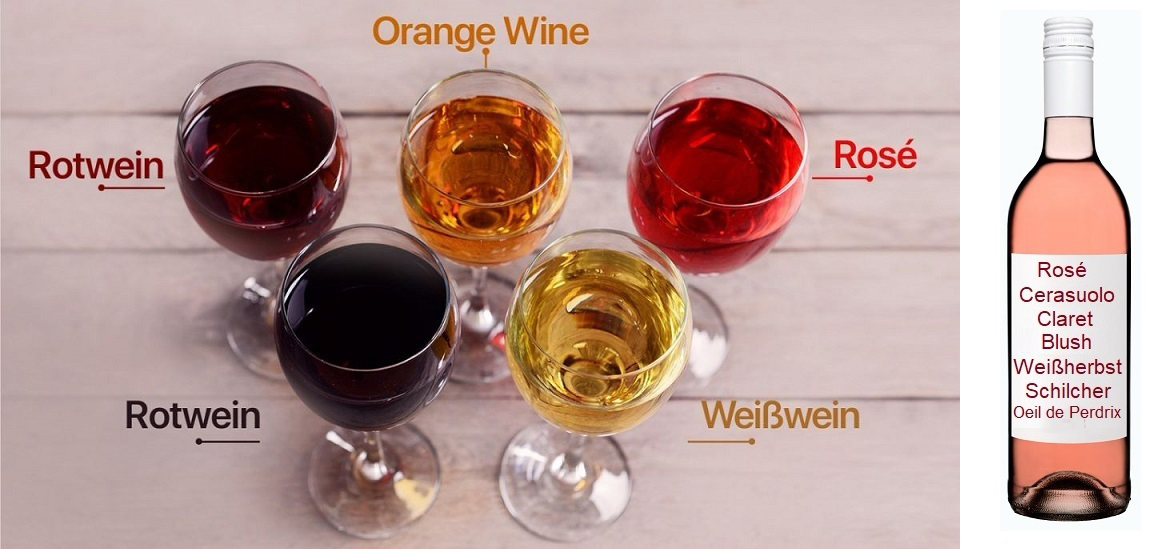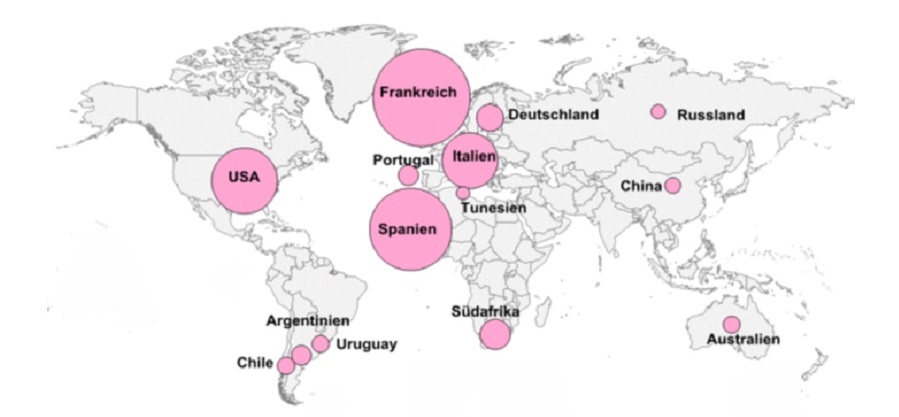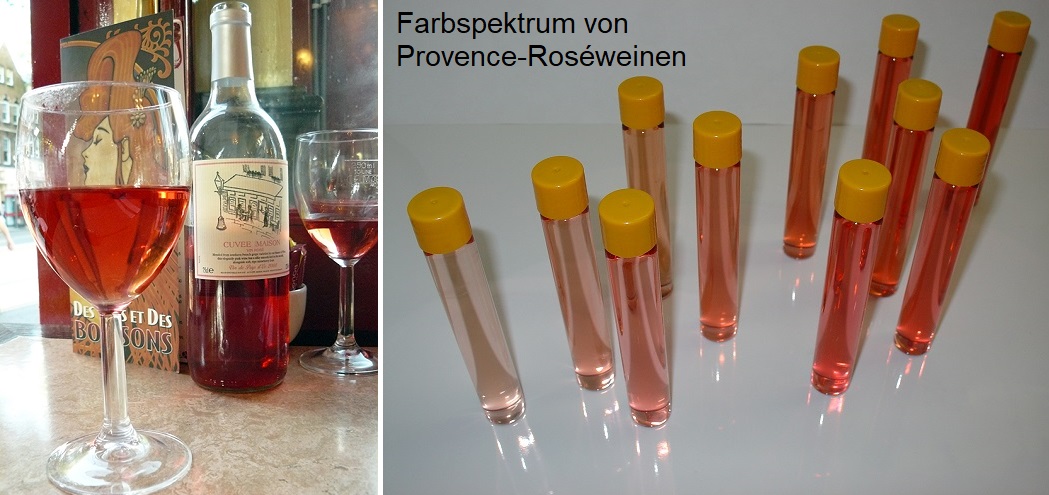Designation for a type of wine with a pale, light red colour. Depending on the intensity of contact with the berry skins, the colour can range from salmon (light red) to cherry (dark red). However, there are no standardised regulations or definitions for rosé wines worldwide. The OIV (International Organisation of Vine and Wine) has no analysis standards that differentiate wines according to their colour. Although there is no precise definition of rosé wine, there are country-specific production methods (see below). As a rule, rosé wines are produced exclusively from red wine varieties and vinified like a white wine, i.e. without mash fermentation and with prolonged contact with the grape skins.
However, there are also rosé wines that are made from a blend (grape/mash or wine) of red wine varieties and, according to country-specific requirements, optionally also white wine varieties (in the case of a grape/mash blend, this is a mixed blend). Which grape varieties are considered red wine varieties or quality wine varieties is also country-specific. There are some white wine varieties with red berry skins such as Roter Muskateller ( Muscat Blanc variety), Gewürztraminer (Roter Traminer) and Pinot Gris, as well as Cereza and other Criolla varieties in South America, which produce a more or less reddish wine.

EU regulations for rosé wine
In June 2009, following fierce protests from some winegrowers' associations, the responsible EU Commission rejected a legislative proposal that would have allowed rosé wine to be produced by simply blending red and white wine. This was intended to eliminate the competitive disadvantage compared to the blending of red and white wines for the production of simple rosé wines, which is permitted outside the EU.
EU Regulation 2019/934
The ban on blending a red wine with a white wine to produce a rosé wine is manifested in Article 8(1) of EU Regulation Regulation (EU) No 2019/934. Rosé wine may not be obtained by blending a white wine (without a PGI or PDO) with a red wine (without a PGI or PDO). The ban on labelling a blend of red wine and white wine as rosé therefore only applies to the lowest wine quality level of wine without origin. Conversely, this means that for rosé wines, a red-white blend of Landwein (PGI) and quality wine (PDO) is or would be permitted.
Country-specific regulations
Each member state of the EU can authorise certain production methods for the quality levels PGI(Landwein) and PDO(Qualitätswein or Prädikatswein) in national wine law. In Germany and Austria, only a wine that has been produced exclusively from red wine varieties and fulfils the legal requirements for a wine with origin (PGI or PDO) may be marketed under the designation rosé wine.
Exceptions
As an exception, blending is also permitted in the production of sparkling wine. In the case of the traditional designations Badisch Rotgold, Schieler and Schillerwein (so-called Rotlinge), which are protected in Germany, white wine grapes and red wine grapes or their mashes are blended or processed. However, according to the provisions of German wine law, these may not be labelled as rosé wine. In Austria, there are no special designations or protected traditional terms that describe or authorise the blending of red wine with white wine.
Red wines
In many wine-growing regions, such as France or Italy, white wine grapes are also permitted in the production of red wine, subject to corresponding exceptions. The grapes are fermented together by means of so-called mixed fermentation. However, these are not rosé wines, but red wines. Due to the generally very low proportion of white varieties, this has no influence on the colour of the wine.
Natural wine
The Orange Wine and Natural Wine types that have become popular in recent years usually have a yellowish-red (orange) colour. However, these may not be marketed as quality wine or labelled as rosé wine.
Rosé wine production
It is difficult to record quantities, as there is no standardised definition and rosé and red wines are often mixed together. Since 2002, the production volume has increased by around 16%. The share of rosé wines in total wine production has remained fairly stable since 2002 and accounts for 8% to 10% of still wine production. France accounts for three quarters with around a third, followed by Spain with a fifth, the USA and Italy.

In many French and Italian red wine-growing regions, rosé wines are also included. In France, these include Bordeaux with Bordeaux Rosé and the darker Bordeaux Clairet, Loire with the main rosé region of Anjou, Languedoc-Roussillon, Provence and Rhône. Tavel from the southern Rhône region of Tavel is known as the "king of rosé wines". Rosé also became increasingly popular in other European countries from the beginning of the 1970s. The days of using unripe or overripe grapes that were unsuitable for a red wine are long gone. Rosé wines generally have a moderate acidity and, unlike many red wines, very moderate tannins. Rosé wines are also ideal food companions for rosé-coloured dishes such as salmon, shrimps or salads with crab as well as pasta and pizza. A dry rosé and grilled meat are a good combination. With a little residual sweetness, they also go well with Asian cuisine.
Brand rosé wines
Two successful branded rosé wines from Portugal that are produced in large quantities are Lancers and Mateus Rosé, which is bottled in Bocksbeutel bottles. In Italy, there are three rosé wines classified at the highest DOCG level: Alta Langa (Piedmont), Franciacorta and Oltrepò Pavese Metodo Classico (both Lombardy). In Austria and Germany, rosé wines became popular from the 1980s as light summer wines; however, the production share is relatively low. A well-known rosé wine from Styria (Austria) is Schilcher, made from Blauer Wildbacher grapes. In Argentina, large quantities of qualitatively very simple, rosé-like draught wines or mass wines are produced from red berry Criolla varieties.
Country-specific designations
A list of all light red wine types. Whether it is a rosé wine according to EU law or country-specific rules is indicated in the respective keyword. Some of these are traditional designations of origin.
- Badisch Rotgold: light red wine, red and white wine grapes - Germany
- Blanc de blancs: white wine/sparkling wine made from white wine grapes - mainly France
- Blanc de noirs: light-coloured wine/sparkling wine made from red wine grapes - mainly France
- Bleichert: old, no longer authorised designation for rosé - Germany
- Blush: light red wine - California (e.g. White Zinfandel) or overseas in general
- Cerasuolo: light-coloured rosato - Italy
- Chiaretto: dark rosato - Italy
- Clairet, Claret: dark rosé or light red wine - England, France/Bordeaux
- Cviček: blend of white wine and red wine - Slovenia
- Gleichgepresster, Gleich'preßter: light-coloured rosé - Austria
- Gris de gris: light red wine made from grey/red berry grapes - France
- Klarett, Klaret: term for rosé - Austria, Czech Republic
- Kokkineli: rosé version of Retsina - Greece
- Kretzer, Krätzer, Höpfwein: light-coloured Rosato - South Tyrol
- Labín: Rosé - in the Mělnická region in the Czech Republic
- Occhio di Pernice: salmon red rosé, e.g. Vin Santo Rosé - Italy
- Oeil de perdrix, partridge eye (J): salmon red rosé - Switzerland
- Opolo, Opol: Rosé - Croatia
- Orange Wine: orange-coloured wine, not an official wine type - many countries
- Rosado: general term for rosé - Argentina, Chile, Portugal, Spain
- Rosato: general term for rosé - Italy
- Rotling: light red wine, red and white wine grapes - Germany
- Roze, Rozé: general term for rosé - Bulgaria, Croatia, Romania, Hungary
- Ryšák, Růžák: light red wine made from a blend of grapes or must - Czech Republic
- Schieler: light red wine, red and white wine grapes - Germany
- Schilcher Rosé - Austria/Styria
- Schiller: light red wine, red and white grapes - Switzerland
- Schillerwein (N): light red wine, red and white wine grapes - Germany
- Siller: dark rosé - Hungary
- Süßdruck, Süßabdruck, Pressé doux: light-coloured rosé - Switzerland
- Vin gris: light-coloured rosé - France
- Weißherbst: light-coloured rosé - Germany

Production process
Rosé is actually much closer to white wine than red wine in terms of production. It is significantly less enriched with anthocyanins (colouring agents), tannins and flavourings than a red wine. In detail, however, there are differences in colour and taste between the individual rosé types, which are mainly due to the grape varieties used and the different lengths of maceration. The five most important production methods are
1 - Direct pressing
In this most common method, the grapes are pressed slowly and gently. Often there is no destemming beforehand. The grape must takes on a slightly reddish colour due to the brief contact with the skins and is then further processed like a white wine, i.e. fermented without mash. In contrast to red wine, there is no maceration (prolonged maceration on the skins) or mash fermentation. This usually results in very light-coloured, rather neutral-tasting rosé wines. This method is often used in the French Provence. In Germany, such wines are known as Weißherbst, in Austria as Gleichgepresster and in Switzerland as Süßdruck.
2 - Short maceration
In this method, the grapes are destemmed using a grape mill, crushed and mash-fermented. After a short maceration period of around 4 to 6 hours, the pink-coloured free-run wine is removed from the skins and fermented like a white wine. In France, this type of wine is poetically referred to as "Rosé d'une Nuit" (Rosé of one night). As a rule, this produces significantly darker and more intensely flavoured rosé wines compared to direct pressing.
3 - Saignée (bleeding)
Saignée ("bleeding" or "bloodletting") is a somewhat modified third method compared to the second. The grapes are crushed but not pressed. However, before the must can take on a darker red colour, part of it is drawn off after 12 to 48 hours or simply extracted by "draining". The rest of the must is further processed as red wine, which is more concentrated and stronger in colour as a result of this process. The rosé is a by-product. Rosé wines produced using this process are easily recognisable because they are particularly dark and very colourful. As the extracted must has a high sugar content, these wines can be very high in alcohol. One of the most famous and best rosé wines of this type is the French Tavel from the southern section of the Rhône.
4 - Blending red wine with white wine
According to EU law, this process is excluded for wines without origin, regulated (or not) on a country-by-country basis for wines with origin and authorised for the production of sparkling wines, including rosé champagne (see above). Depending on the country, different regulations apply to this process. White wines can also be fortified with concentrated, coloured musts to produce a rosé wine. When fortifying with musts and concentrated musts, the concentrated must added does not have to have a similar colour to the must to be fortified.
5 - Brightening red wine
Tannins or tannins are removed from a red wine by fining (mainly using PVPP and activated charcoal). This gives it a lighter colour and makes it much less astringent.
Blanc de noirs
Blanc de noirs (meaning "white wine made from black grapes") is a light-coloured wine made from red grapes, which is particularly used for champagne or sparkling wine. It can have a light (white) colour, as is generally the case with champagne, but also a slightly reddish colour. If the colour is somewhat darker, it is called taché (meaning "stained") in France. In Germany, "Blanc de noirs" can be used as a supplementary term for Weißherbst. In Austria, the term has been authorised since 2014. However, a reddish-coloured wine with this designation is not necessarily a rosé according to EU law, as its production is not defined by wine law.
Further information
For more information on this topic, see also wine enjoyment (from opening the bottle to savouring it) and wine with food (which wine goes with which food). For the production of alcoholic beverages, see Champagne (sparkling wines), distillation (distillates), spirits (types), winemaking (wines and wine types) and wine law (wine law issues).
Wine glasses: © Olga Yastremska / 123RF.com
edited by Norbert F. J. Tischelmayer
Bottle: Norbert Tischelmayer
Colour vials: VARNA Translated from fr.wikipedia to Commons, CC BY-SA 3.0, Link
Map: OIV-CIVP 2015
Bottle and glass: By Mike_fleming - Flickr: Cafe Rouge House Rose, CC BY-SA 2.0, Link
Voices of our members

There is a vast number of sources on the web where one can acquire knowledge about wine. But none has the scope, timeliness and accuracy of the information in the encyclopaedia at wein.plus. I use it regularly and rely on it.
Sigi Hiss
freier Autor und Weinberater (Fine, Vinum u.a.), Bad Krozingen